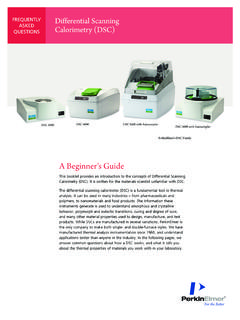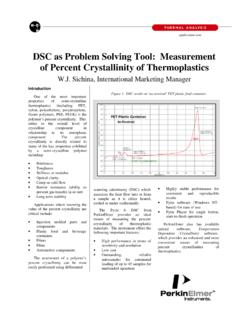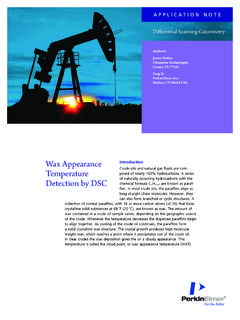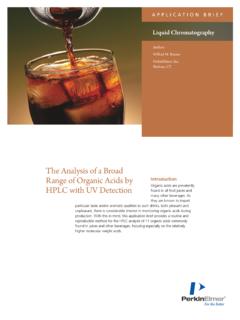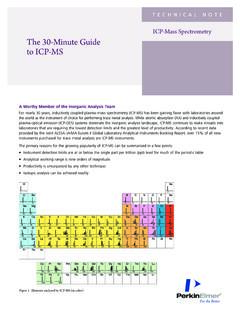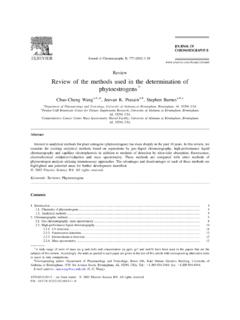Transcription of The Elemental Analysis of Various Classes of …
1 APPLICATION NOTEA uthor:Robert F. Culmo, Senior Staff Scientist perkinelmer , Inc. Shelton, CT Introduction The perkinelmer PE 2400 CHN Elemental Analyzer1 is a state-of-the-art Elemental analyzer designed for the rapid determination of carbon, hydrogen, and nitrogen content in organic compounds and many other types of materials. The design employs sophisticated solid-state electronics and microprocessor technology, which provide the dual capability to perform the Analysis and the computations in a self-contained system. This design is based on our own research and on the cumulative experience of thousands of instrument users over a period of twenty years. The Elemental Analysis of Various Classes of Chemical Compounds Using CHN Elemental Analysis22 Improvements made in the analytical design include the three major zones of the system: the combustion area, the gas control area, and the separation and detection area. Enhancements in these areas provide reduced analytical time and improved maintenance and analytical performance of the system.
2 In the combustion area better control and versatility is provided for handling the many Classes of chemical materials that exist in industry and research. The versatile combustion design shown in Figure 1 provides more degrees of freedom for introduction of oxygen. These options include control for oxygen added to the combustion tube before the sample drop, after the sample drop, and during the dynamic phase of combustion. Also, a provision for extending the static combustion time is provided. These time intervals are controlled from 1 second to 300 seconds (5 minutes). The combination of reagents used in the combustion zone includes chromium oxides, silver tungstate on magnesium oxide, and silver vanadate. These provide both efficient oxidative properties and a high-capacity scrubbing efficiency, ensuring the complete oxidation of volatile products and the effective removal of common interferences. These features provide the necessary versatility for handling virtually all sample types wherever the determination of carbon, hydrogen, and nitrogen serves a useful analytical purpose.
3 This includes, for example, the Analysis of organics, polymers, coals, fuel oils, oil shales, gasoline, ocean sediment, and ocean and air particulates. This study attempts to answer the question of what happens when Various Classes of materials are analyzed which are known to be relatively "difficult" to analyze by other instruments or by conventional techniques. This includes materials known to be refractory (difficult to combust) or containing elements or functional groups that interfere with the proper and complete combustion of the compound and with the detection system of the apparatus. These include polynuclear aromatic compounds, steroids, heterocyclic nitrogen derivatives, halogenated and sulfonated compounds, volatile organics, organosilico and phosphorus derivatives, nitro-compounds, organometallics, and pure carbon forms. ExperimentalThe results presented were obtained with a standard PE 2400 CHN Elemental Analyzer. The combustion tube packing was supplied with the instrument and consisted of the following components: EA-1000 (chromium oxidizer), silver tungstate on magnesium oxide, and silver vanadate.
4 perkinelmer Copper Plus (+) and Cuprox were used in the reduction tube. Unless otherwise noted in the discussion, the compounds were sampled in standard fashion using tin capsules for nonvolatile materials and sealed aluminum capsules or pans for liquids and materials having an appreciable vapor pressure. The samples were weighed with a perkinelmer AD-6 Autobalance. ResultsThe following reviews in detail the Elemental Analysis of Various Classes of compounds using the perkinelmer 2400 CHN Elemental Analyzer. Polynuclear Aromatic Hydrocarbons Polynuclear aromatic compounds provide a valuable test of an Elemental analyzer's capability with respect to accuracy and combustion efficiency because of their exceptional high carbon content. Achieving a result within for a 95% carbon content obviously demands more of an analyzer than at a more typical 60% level. With other analyzers, linearization of the results is required to achieve the performance found with the PE 2400 CHN (Table I).
5 If the sample size exceeds milligrams, the optimize combustion control feature may be used to certify complete sample 1. Polynuclear Aromatics Compound Theory (%) Found (%) C H N C H N ANTHRACENE -- -- CHRYSENE -- -- NAPHTHALENE -- -- Figure 1. The EA 2400 optimizes combustion by allowing control of several oxygen fill stepsOptimize Combustion Control1. Oxygen fill of combustion tube2. Oxygen introduced before delay3. Extend combustion time 4. Oxygen introduced after delayOxygen FillSample DropExtend Combustion Oxygen 1 Oxygen 23 Steroids Large complex molecules such as steroids produce a variety of combustion fragments when large sample sizes are used.
6 This requires good efficiency from the catalytic combustion reagents. Steroids and related compounds are routinely determined under standard conditions (Table 2). Table 2. Steroids Compound Theory (%) Found (%) C H N C H N CHOLESTEROL -- 11. 80 -- 11. 89 -- TESTOSTERONE -- --Nitro-Compounds Certain nitro-derivatives have been reported to be a problem because low nitrogen results ( ) were observed. This problem relates to the observations of Swift2 who speculated that it was due to the absorption of nitrogen oxides by the copper oxide from the combustion and reduction zones.
7 The translation of his observations to the PE 2400 CHN relates to the produced copper oxide in the reduction zone. This occurs because large amounts of nitrogen oxides are produced with these particular compounds thereby producing the effect observed. Although not proven, it is conceivable that some loss of nitrogen oxides occurs in the reduction zone by absorption or reaction. Specific compounds that have been observed to exhibit this problem include 1-chloro, 2, 4 dinitrobenzene, m-dinitrobenzene, and 2, 4 dinitrophenol. The presence of excess oxygen leads to the generation of nitrogen oxides thereby producing low nitrogen results. To eliminate the possibility of excess oxygen, features of the PE 2400 CHN are used to reduce the amount of oxygen. At the same time the sample size was increased to 4-7 mg. By making these adjustments in conditions, satisfactory results were obtained. This procedure is also useful for determining nitrogen content in explosive materials such as pentaerythritol tetranitrate (PETN).
8 Table 3. Nitro-Derivatives Compound Theory (%) Found (%) C H N C H N 1-CHLORO, 2, 4 DINITROBENZENE m-DINITROBENZENE Heterocyclic Nitrogen Derivatives Heterocyclic nitrogen compounds have historically been classified as being difficult to combust3 compared to other organics. The nitrogen in the ring requires more vigorous oxidation conditions to ensure complete conversion to the desired products. Results tabulated in Table 4 demonstrate that this problem is not encountered with the PE 2400 4. Heterocyclic Nitrogen Derivatives Compound Theory (%) Found (%) C H N C H N CAFFEINE URIC ACID UREA MELAMINE 4 Polymers Elemental Analysis has been used for a number of years to characterize homopolymers, copolymers, blends, and resin formulations.
9 An Elemental Analysis for C, H, and N can be the most direct, fastest, and least ambiguous method for determining a copolymer or blend composition. While most of these materials shown in Table 5 present no problems, some polymers can be somewhat refractory. When this is indicated, an additional 2 seconds is recommended for the oxygen fill. Halogenated and Sulfonated Compounds Elemental analyzers should function with undiminished performance for compounds containing common elements such as halogens and sulfurs. Because of this requirement the PE 2400 CHN Analyzer is designed with a large excess of high efficiency scrubbing reagents -including chromium oxide, silver tungstate, magnesium oxide, and silver vanadate. The ability to obtain results of the quality shown in Table 7 is an impressive feature of the PE 2400 CHN's design. Table 7. Halogenated and Sulfonated Compounds Compound Theory (%) Found (%) C H N C H N HEXACHLOROBENZENE -- -- -- -- -- -- PTFE -- -- -- -- -- -- PHENYLTHIOUREA p-BROMOACETANILIDE SULFANILIC ACID CYSTINE
10 Table 5. Polymers Compound Theory (%) Found (%) C H N C H N NYLON 6 STYRENE/25% ACRYLONITRILE PTFE -- -- -- -- -- -- Volatile Organics Volatile organic liquids can, if they are low boilers, present a problem with encapsulation and combustion.


